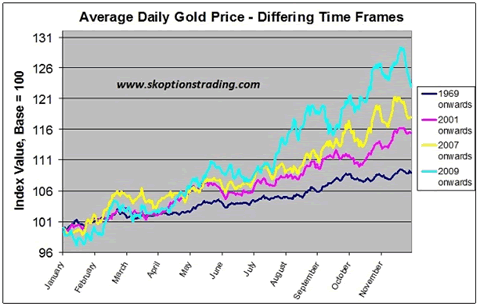Gold Takes a Spring Break
Post on: 30 Май, 2015 No Comment

Posted by Wealth Wire — Wednesday, May 2nd, 2012
There has been a range of intelligent analytical opinions recently espoused, seeking to explain the action in the gold price this last six months. Whilst we have found articulations focused on consolidation most conducive, quality analysis has not just been found this side of the debate. Outside of lazy assertions that the gold bubble has burst, the debate has been heated but useful. It is always as such for gold. In the office we call the gold market the fox-hunting debate of the financial markets; very few participate but many have strong and at times heated opinions on the matter.
A quick and useful piece on recent price action in the precious metals was recently published by Jordan Roy Byrne at The Daily Gold. Mr Roy Byrne sees gold and silver as correcting multi-year advances, noting that these corrections are now evolving into more extended consolidations. A decline in volatility along with general interest and sentiment in the market are deemed important to put a bottom in in the precious metal prices. During an extended consolidation we are advised that these bottoms take time to develop.
Consolidation in the gold price
Mr Roy Byrne starts by looking at the gold price, and he finds price and market behaviour befitting a consolidation:
Lets start with gold. At the top we plot the average true range (ATR) indicator which is a helpful volatility indicator of sorts. When it becomes stretched or rises too high on the chart, we can expect a reversal in trend. Note that the ATR indicator often hits a low prior to or soon after the start of an impulsive advance. This occurred with every major move with the exception being 2008 when volatility peaked during the financial crisis which sent gold down 30%. Also, the yellow shows what was an uncorrected two year advance from $900 to $1900. This 25-month advance has been followed by an 8-month correction.
Using Fibonacci retracements and technical analysis Mr Roy Byrne sees the gold price continuing to correct for a few months more. So perhaps gold is set to slip quietly into its oft-cited summer lulls before well see any decisive further price action?
A look at the commitment of traders report (COT) for gold might also be instructive. Mr Roy Byrne cites commercial short positions at near three year lows, implying very limited speculation in the market. Added to this open interest has declined since late 2010 and sits at a multi-year low. Levels of participation, let alone speculation, are at notably low levels. Such thin markets are potentially more illiquid and may be poised forprice discovery in a new direction.
The correction in gold has become a consolidation. Whilst a picture of a bottom in the gold price is building, the abovementioned conditions may not automatically manifest into a rising gold price immediately. Gold investors may have to wait a few months longer.
Silver echoing gold, but with more volatility
Action in the silver price. although exhibited over a longer period, exhibits some apparent similarities to action in the gold price this last 8 months. Silver did have a more impressive run to digest. Mr Roy Byrne reminds us that:
Periods of low volatility have coincided with the start of major moves in silver. The examples are 2005, 2007, 2009 and 2010. Silver advanced from $8 to $49 in about 29 months. The market has been in a correction for 12 months. Applying Fibonacci analysis, wed expect the correction to last 11 months, 14.5 months or 18 months. Thus, silver could continue to consolidate for several months.
When looking at the COT for silver Jordan Roy Byrne notes commercial short positions are at 26.5K contracts which is relatively close to the 10-year low seen at the end of 2011 and that open interest has begun to climb higher but it remains well below the peaks seen from 2009-2011.
As for gold, the discussion for silver above does not necessarily mean imminent price moves higher for the restless metal. But, silver does appear to also be doing some consolidating after its headline grabbing run up over 29 months post the Credit Crunch. As Mr Roy Byrne advises:
Markets cycle between periods of advance, correction and consolidation as well as periods of high volatility and low volatility. In the case of Commodities, these states tend to be magnified. Advances can be sharp and fast and the same goes for corrections. Because of this, multi-month consolidations are often required to digest these big moves. When the market finds an equilibrium, which occurs at low volatility, the primary trend can reassert itself.
The point is, gold and silver made major moves in recent years lasting 25 months and 29 months. Such moves are not corrected and digested in a period of only a few months. As we should know by now, it takes many months. As the market gets deeper into these corrections and they become consolidations, volatility falls, bullish sentiment recedes and general interest abates. These are the conditions that precede important lows This is how markets work.

Extended holidays for gold and silver
In his concluding comments Jordan Roy Byrne contextualises his thoughts of further to go in these gold and silver price consolidations with reference to the summer lulls in the precious metals and how the consolidation might end as the precious metals awake from their summer slumber.
The middle of the year and summer period has often been cited as a period of price weakness for gold and silver, and a range of other asset classes in fact. The saying sell in May and go away is familiar to many. A February piece from Bob Kirtley of Skoptionstrading.com took a detailed look at this and whether seasonality in the gold price really does mean anything for gold investors. Within his analysis Bob Kirtley writes that:
Between late April and early July, gold has been very flat over the last 11 years, as shown by the graph with an average rise of only 1.4 index points or just under 1.3% for the period, which corresponds to an annualized return of 6.1%, paling in comparison to the average return annually between 2001 2011 of around 19%.
These slow months are known as the summer doldrums. People love to speculate what the reason behind the summer slowdown is. Who knows what the actual reason is, but it could simply correspond with traders/investors taking vacation and demand slowing for that reason. You would imagine that demand for gold will correlate somewhat with global economic activity and with that activity slowing in summer, so too does the demand for gold. A key part may also be simply the perception of the summer doldrums, investors expect things to be quiet around this time of year and therefore refrain from taking large positions, which results in the market being more subdued in a self-fulfilling prophecy.
Mr Kirtley also finds similar seasonal gold price action also exhibiting itself over a range of time periods noting that the peaks and troughs closely correspond in each time frame. Golds seasonal nature has been exhibited since 1969, and if anything appears more pronounced over the shorter time frame.
Modelling the gold price
Mr Kirtley uses his data to model what previous seasonality suggests gold prices could be at different times later this year (2012). With reference to a February 8 th gold price of $1,746/ounce the model throws out some interesting results.














